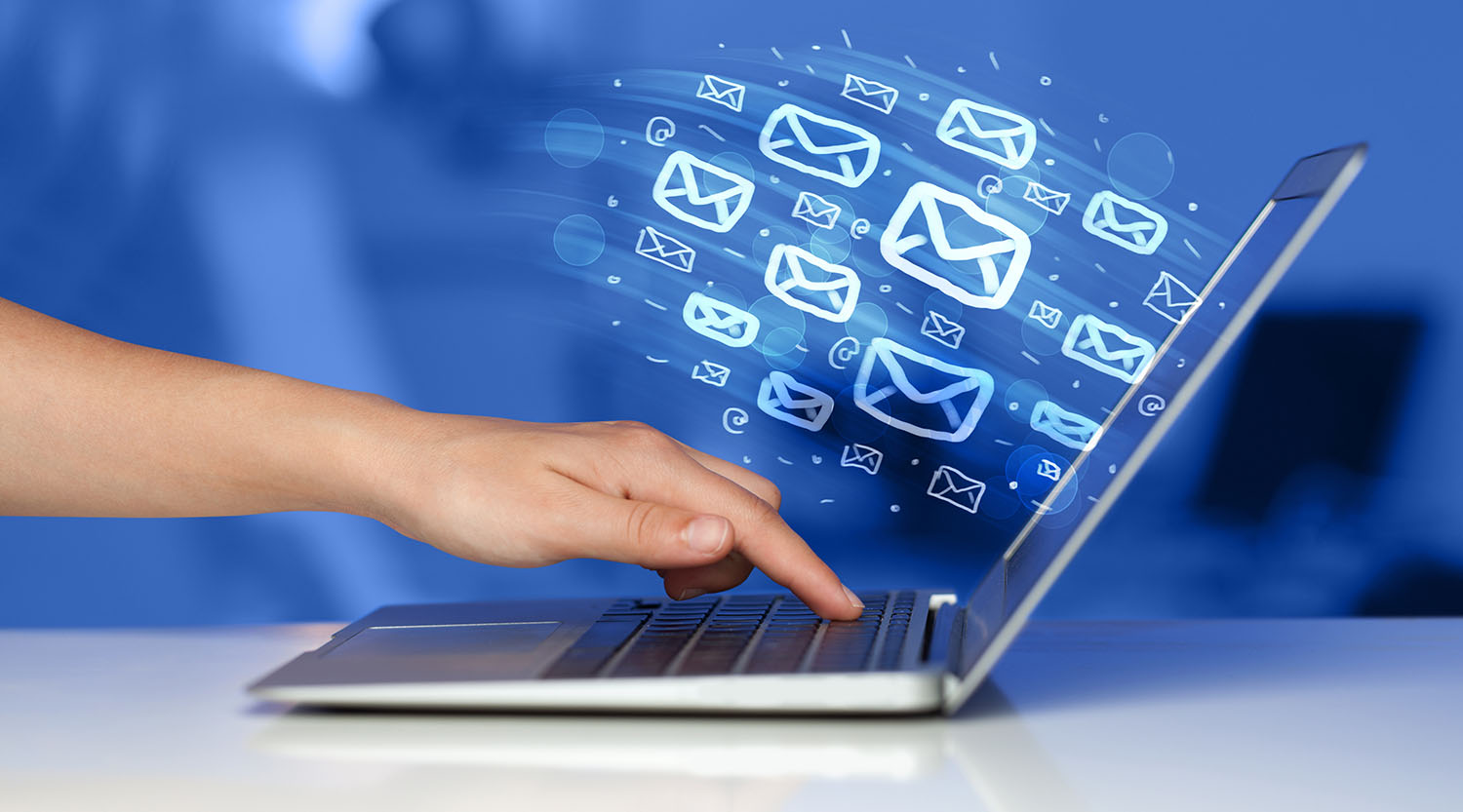
One of the best ways to stay in touch with your donors on a consistent basis is through a nonprofit email newsletter.
When done well, email newsletters can be fast and cheap for you and heartwarming for your donor, basically meeting everyone’s needs.
Unfortunately, most email newsletters look like someone created it in a rush, throwing a bunch of random things together so they could call it done.
Random doesn’t cut it. Neither does boring.
So, what does it look like when it’s done well?
Purpose of your nonprofit email newsletter
Your email newsletter has a specific purpose. It’s meant to
- Stay in touch with donors to create regular communications (consistency).
- Make the donor feel good about supporting your mission and even feel like they’re part of the family (connection).
- Invite donors’ feedback to establish 2-way communication (courtesy).
Basically, your email newsletter is there to keep the lines of communication open and to meet the donor’s need to feel good about your nonprofit.
You see, it’s about them and their desire to know what’s going on, not necessarily for you to ask for money, ask them to buy a ticket to your event, and ask them to volunteer (which is too many asks at once!).
Your donor newsletter gives you the chance to write as one person to another person with an authentic, warm connection. If you write too formally, write in 3rd person, or write about how great your nonprofit is using ego-centric language, it doesn’t feel connecting at all.
So, let’s get your nonprofit email newsletter right so it makes your donors feel good and helps you build the loyal donor base you need to fully fund your mission.
Your newsletter’s audience
Who you should sent your newsletter to?
Does it go to donors? Volunteers? Are you sending it to program participants or others?
It’s a bad idea to try to combine every possible audience into one simply to make it easier for you.
[bctt tweet=”The purpose of your nonprofit’s email newsletter is to meet your donor’s need for information and connection. It’s about their satisfaction, not your convenience.” username=”@sandyrees”]
Your donors should be the main focus of your newsletter. Depending on your organization, it might make sense to include volunteers, too. But be careful about including program participants because the information they need may make donors feel like outsiders or make the newsletter seem irrelevant to them (and that’s no good).
The right nonprofit email newsletter format

Use a tool like Constant Contact, Mail Chimp, or something similar to send out your email newsletter. These tools are affordable, easy to use, and have great templates you can customize for your nonprofit.
Your regular email (e.g. Outlook, Hotmail, or Gmail) is not set up for email marketing and has significant limitations that can hurt rather than help your email marketing efforts. If you try to use your regular email, you run the risk of being marked as spam, looking unprofessional, and not being able to measure open rates. A system like Constant Contact complies with U.S. CAN SPAM laws so you don’t have to worry about it.
Using a template from an email tool is ideal for your newsletter because these templates are made to be easily read online or on mobile (more about that in a minute).
Don’t copy your print newsletter into an email or ask people to download a PDF of your print newsletter. Neither is a good option and makes you look lazy. The truth is that all the other nonprofits your donor supports have nice-looking newsletters and you need one, too.
Good templates will have a built-in unsubscribe link, which is a good thing. You need to give people a way to opt out if they decide they don’t want to receive your newsletter any longer. Sad day, I know. But hey, I’m sure you’ve opted out from things that just no longer captured your attention.
What should be included (email newsletter template)
The short answer to what to include in your newsletter is anything your donor will love. Set her heart on fire with stories of real lives and real change – it’s what she wants to know after giving.
Here’s a rough email newsletter template you can follow to make sure you’re including only the good stuff in your donor newsletter.
What should be left out
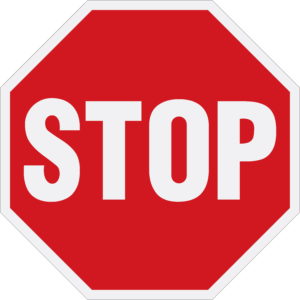
Including the wrong things in your newsletter will kill its success. Boring or irrelevant pieces don’t support the purpose of your nonprofit email newsletter and they don’t help build strong donor relationships. So leave these out:
1. Letter from your Executive Director or Board chair. These are too predictable, and sorry, but hearing from either of these two people is not on the top of the donor’s priority list.
2. Endless updates about past events. If you have lots of events to report on, you’re doing too many events! And really, if you’re recapping event after event, you’re spending all your time looking back instead of looking ahead. Plus, if people didn’t attend your car wash, they don’t really care that you raised $225.
3. Lots of stats and facts. Lots of numbers make most people glaze over and that won’t increase reader engagement. Choose one or two that are relevant and interesting and include them along with a story that illustrates them.
4. Cheap cause marketing. Don’t ask people to support your Amazon Smile, grocery store affinity program, search engine donation scam, or anything else that doesn’t generate at least a couple of thousand dollars. Seriously, please don’t promote these. You only have so many chances to ask people to engage with you. Don’t waste one on something that will generate very little for you in return.
Remember that what you most want to share and what the donor really wants to read may not be the same thing. Check out the Fundraiser’s Paradox from Bluefrog Fundraising.

Decide on your Call-To-Action before you start writing
A Call-To-Action (or CTA) is anything you ask your reader to do.
For example, if you ask for a donation, that’s a CTA. Asking people to volunteer is a CTA.
What counts as a CTA? It’s a CTA when you ask people to
- Give a donation
- Sign up for monthly giving
- Buy an event ticket
- Volunteer
- Purchase something from your Wish List
- Attend your Buffalo Wild Wings night
- Share something on social media
- Comment on your blog post
The problem is that if you ask, ask, and ask some more, you’ll wear people out. You’ll see your engagement rate drop and unsubscribe rate climb.
Good fundraising requires a balance of asks and non-asks. We recommend that you have 3 good, warm non-asks (also called Communications) for each ask.

That means if you want your newsletter to count as a non-ask/communication, you can’t outright ask for money and your CTA needs to subtle. Your leading story needs to be so strong that it’s all the donor remembers after they read your newsletter.
Your email newsletter’s CTA might be “hit reply and tell us what you think” or “share this with a friend.” Both are a good way to get people to take an action with them feeling over-Asked.
Make your nonprofit email newsletter readable
It won’t do you any good to create and send a newsletter if it’s hard to read. Follow these tips to keep the readability high and the boredom low.
No acronyms or jargon. People won’t understand your organization’s insider language, so don’t use it when you communicate with donors and prospects. Honestly, if you use acronyms and jargon in your communications, you run the risk of making people feel dumb. I guarantee you they won’t take any action if that’s how they feel.
Short sections and headings. Don’t let a story go on and on. Keep it short, crisp, and to the point. Break long pieces of text into smaller sections with just a few sentences at the most in each section. Use headlines to let the reader know what to expect in each section. (Notice how this article is put together with short paragraphs and lots of sections.)
Good images. Use graphics, charts, photos, and video to break up the text and give the reader some eye candy. The right image can boost readability, keep the donor reading, and create an emotional connection that fuels the donor’s passion for your cause.
About that subject line…
Your subject line has one job – to get the email opened.
If your reader doesn’t open your email, they can’t read your email.
That means all the time you just spent writing it was wasted.
So please, for the love of all things holy, please do NOT use the word “newsletter” in the subject line of your newsletter! It’s like a flare, warning donors that the contents will be just as bland as the subject line.
For better subject lines, try using a question to pique the reader’s curiosity. Or find a way to connect with pop culture, state something controversial, or create a sense of urgency.
Remember that all people are tuned in to station WIIFM (What’s In It For Me) and the subject line “April newsletter” doesn’t give your reader any motivation to open and read.
So, be ready to spend a little time writing several draft subject lines until you get it just right.
Here are some good email newsletter subject lines I’ve seen lately:
- “Time for a Pup-Date!”
- “Welcome Ruby!”
- “Severely sick kittens are now thriving”
- “Do you like love stories?”
- “Chickens are like T-Rex”
- “Accidents happen…”
Make it mobile friendly
 About half of all email is opened and read on mobile devices.
About half of all email is opened and read on mobile devices.
That includes your donor email newsletter.
That means you CAN’T format your newsletter in columns and expect people to read it. They just won’t.
Readability boosts engagement rates so pay attention to how readable your newsletter is.
Think about it – if people can’t read it because the font is too small, the columns are hard to follow, or the colors are weird, they won’t read it.
No one wants to work hard to read your newsletter, so make it super easy to read, especially on mobile devices.
Inboxes are flooded with requests, updates, and coupons. No one wants to read another newsletter. That’s why your nonprofit email newsletter MUST stand out, especially on mobile devices.
And that’s why we recommend you send yourself a test newsletter to make sure it’s pristine before you send it to your donors.
Send your nonprofit email newsletter consistently
Consistent communication with your donors is the backbone to building relationships. So, make a commitment to send your newsletter monthly. Sending it less frequently isn’t often enough for them to feel connected to your cause and frankly they’re likely to forget about you in between editions.
Pick a date and send your donor newsletter consistently on the second Tuesday of every month or the 15th of every month or whatever works for you.
Stay away from the first or last of the month (which is roughly the same thing, right?). In the US, there are too many major holidays around that time and you tend to lose donor’s attention during holiday time.
The point here is to choose a time and be committed to sending your email newsletter out every month at that time so donors start to expect it.
Build yourself a production schedule so you know when to start working on your newsletter, giving yourself enough time to get it written and edited before you click “Send.”
Measuring success
While there may be some national benchmarks for some of these numbers, the smartest thing you can do is measure against yourself. What’s YOUR nonprofit’s typical open rate or click through rate? If your email service doesn’t provide you with a report, then create yourself a spreadsheet and start tracking how each newsletter is performing so you can find out what your averages are.
By the way, the better job you do of connecting with your donors, the higher your numbers will be. Some of our clients get 40% to 60% open rates!
Also pay attention to feedback from your readers, whether they email you, comment on social media, or mention something to you in person. Those anecdotal bits can give you valuable insight into your reader’s thoughts and impressions. Chances are good if one person tells you they loved the story in your last newsletter there are others who think so too, but they just didn’t bother to tell you.
Here’s a great example of a good donor newsletter from our friends at Draft Gratitude:
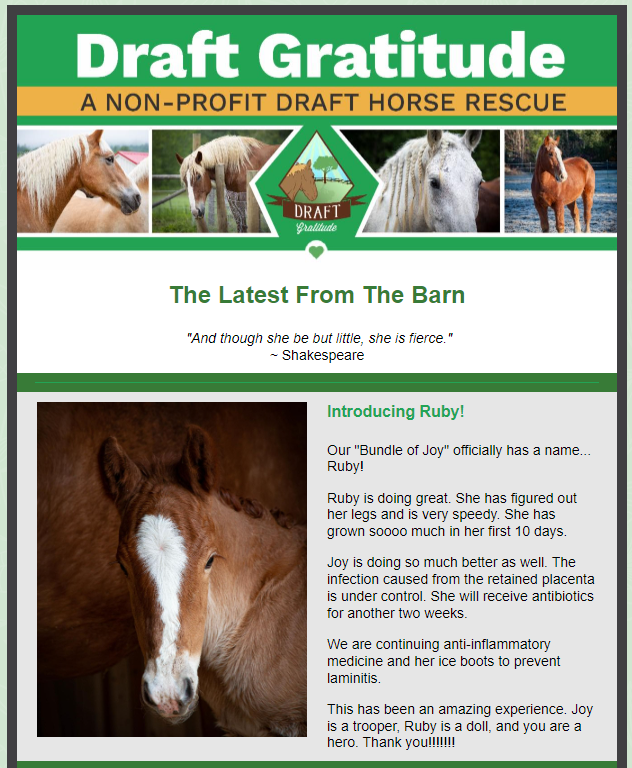
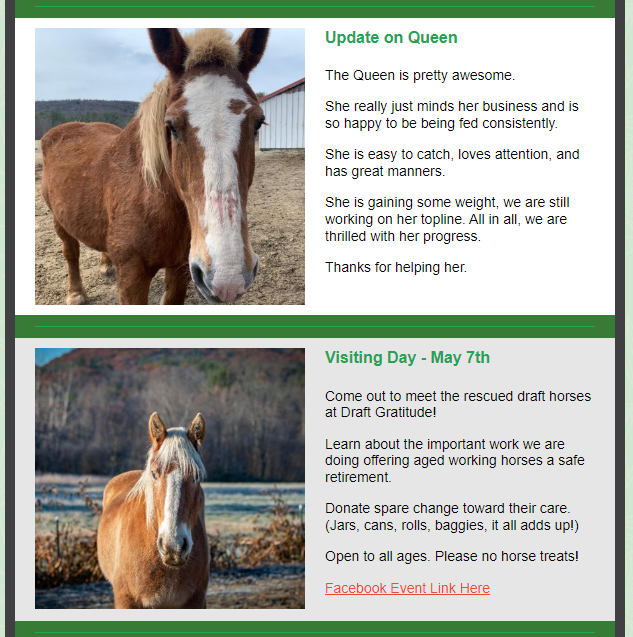
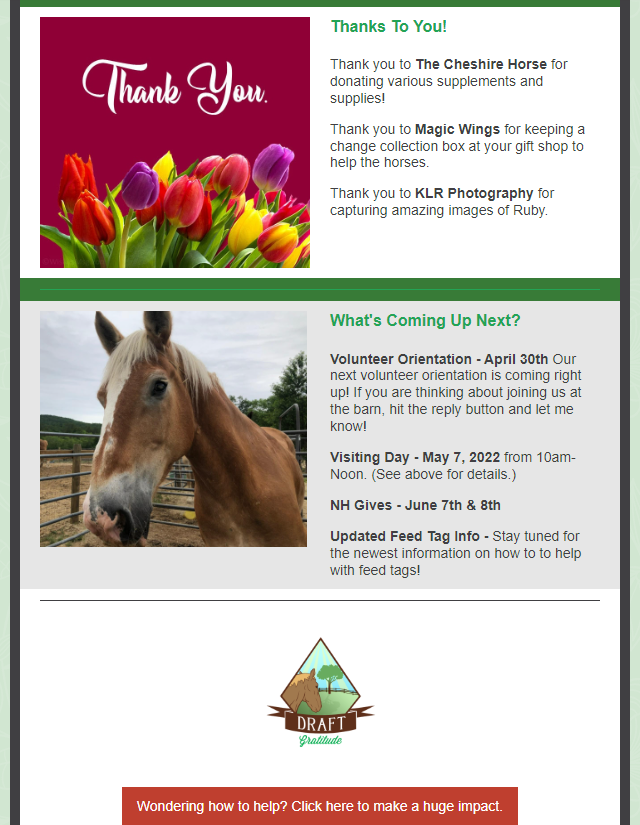
The Bottom Line
If you want donors to pause in the middle of information overload to read your nonprofit email newsletter, you must make it worth their while. Keep it interesting, easy to read, and full of emotion, and they’ll keep opening and clicking to find out more.
Other resources
Canva (www.canva.com) has hundreds of templates for both print and email newsletters. Canva is easy to use and free to nonprofits (just register with them and they’ll unlock all the cool tools for you!). See also, Canva’s Newsletter Templates.


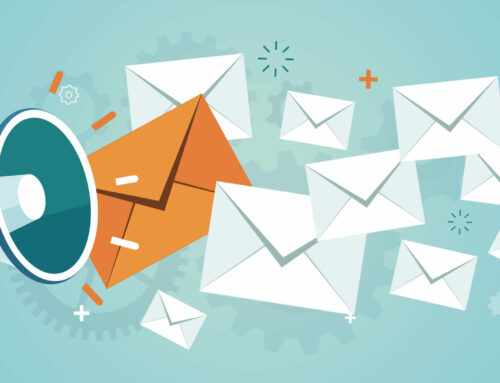


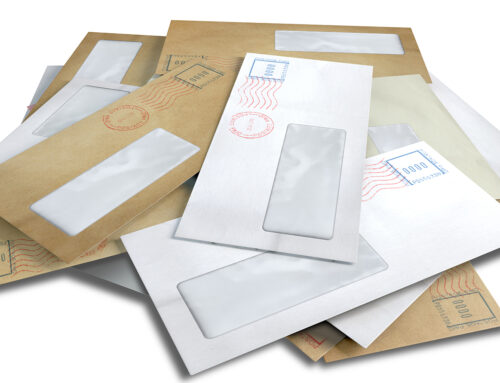
Thank you! Really helpful!
Awesome! If you use any of these ideas, I’d love to see your revised newsletter!
Well done! I don’t think I’ve seen a more succinct or practical article. Great job giving value.
Thanks Andy!! Now, I expect to see great newsletters from BESTWA! 😉